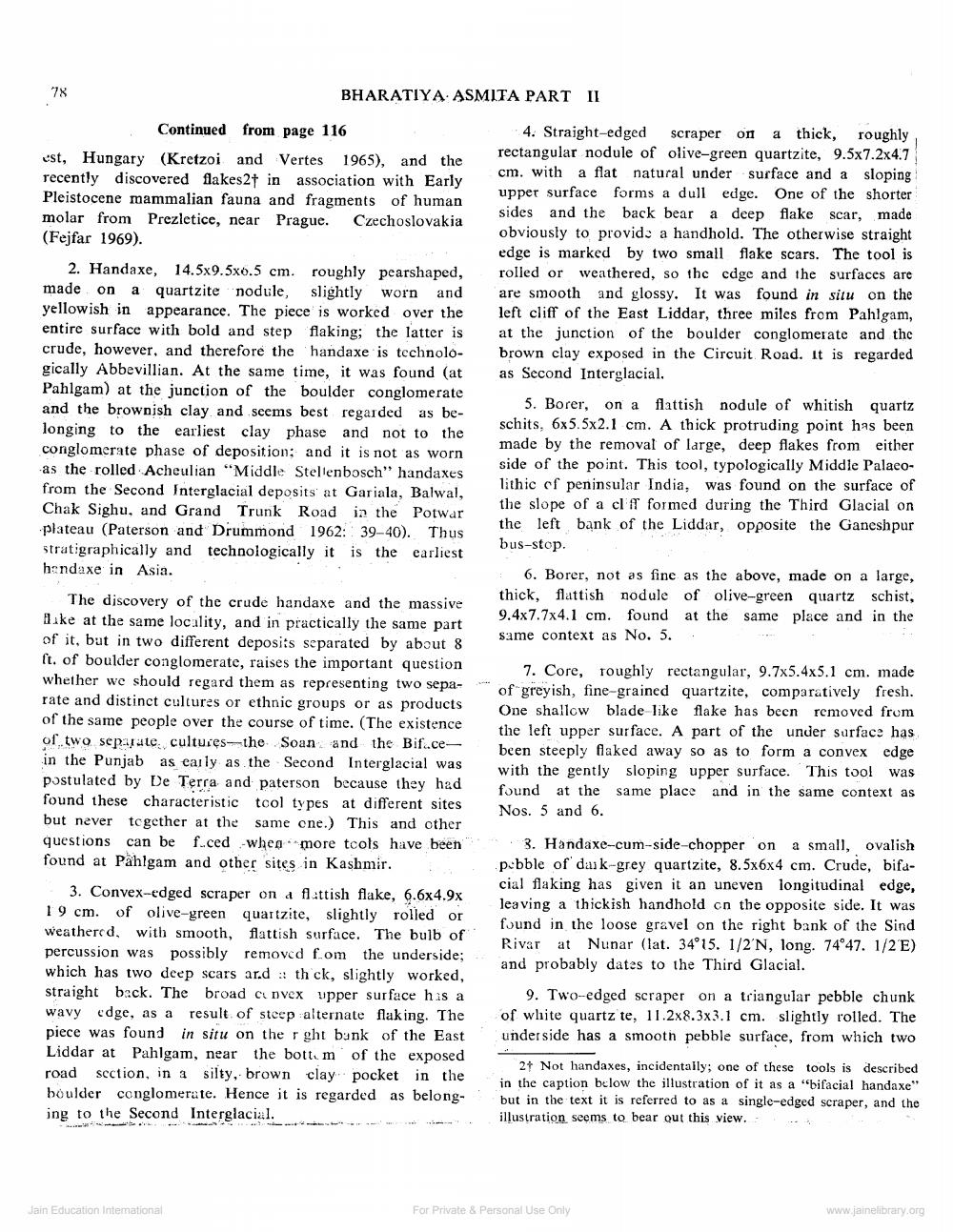________________
78
BHARATIYA ASMITA PART II
Continued from page 116
est, Hungary (Kretzoi and Vertes 1965), and the recently discovered flakes2† in association with Early Pleistocene mammalian fauna and fragments of human molar from Prezletice, near Prague. Czechoslovakia (Fejfar 1969).
2. Handaxe, 14.5x9.5x6.5 cm. roughly pearshaped, made on a quartzite nodule, slightly worn and yellowish in appearance. The piece is worked over the entire surface with bold and step flaking; the latter is crude, however, and therefore the handaxe is technológically Abbevillian. At the same time, it was found (at Pahlgam) at the junction of the boulder conglomerate and the brownish clay and seems best regarded as belonging to the earliest clay phase and not to the conglomerate phase of deposition; and it is not as worn as the rolled Acheulian "Middle Stellenbosch" handaxes from the Second Interglacial deposits at Gariala, Balwal, Chak Sighu, and Grand Trunk Road in the Potwar plateau (Paterson and Drummond 1962: 39-40). Thus stratigraphically and technologically it is the earliest handaxe in Asia.
The discovery of the crude handaxe and the massive Bike at the same locality, and in practically the same part of it, but in two different deposits separated by about 8 ft. of boulder conglomerate, raises the important question whether we should regard them as representing two separate and distinct cultures or ethnic groups or as products of the same people over the course of time. (The existence of two separate cultures the Soan and the Bif..cein the Punjab as early as the Second Interglacial was postulated by De Terra and paterson because they had found these characteristic tool types at different sites but never together at the same one.) This and other questions can be faced when more tools have been found at Pahlgam and other sites in Kashmir.
3. Convex-edged scraper on a flattish flake, 6.6x4.9x 19 cm. of olive-green quartzite, slightly rolled or weathered, with smooth, flattish surface. The bulb of percussion was possibly removed from the underside; which has two deep scars ar.d: th ck, slightly worked, straight back. The broad convex upper surface has a wavy edge, as a result of steep alternate flaking. The piece was found in situ on the r ght bank of the East Liddar at Pahlgam, near the bott. m of the exposed road section, in a silty, brown clay pocket in the boulder conglomerate. Hence it is regarded as belonging to the Second Interglacial.
Jain Education International
4. Straight-edged scraper on a thick, roughly rectangular nodule of olive-green quartzite, 9.5x7.2x4.7 cm. with a flat natural under surface and a sloping upper surface forms a dull edge. One of the shorter sides and the back bear a deep flake scar, made obviously to provide a handhold. The otherwise straight edge is marked by two small flake scars. The tool is rolled or weathered, so the edge and the surfaces are are smooth and glossy. It was found in situ on the left cliff of the East Liddar, three miles from Pahlgam, at the junction of the boulder conglomerate and the brown clay exposed in the Circuit Road. It is regarded as Second Interglacial.
5. Borer, on a flattish nodule of whitish quartz schits, 6x5.5x2.1 cm. A thick protruding point has been made by the removal of large, deep flakes from either side of the point. This tool, typologically Middle Palacolithic of peninsular India, was found on the surface of the slope of a cliff formed during the Third Glacial on the left bank of the Liddar, opposite the Ganeshpur bus-stop.
6. Borer, not as fine as the above, made on a large, thick, flattish nodule of olive-green quartz schist, 9.4x7.7x4.1 cm. found at the same place and in the same context as No. 5.
7. Core, roughly rectangular, 9.7x5.4x5.1 cm. made of greyish, fine-grained quartzite, comparatively fresh. One shallow blade like flake has been removed from the left upper surface. A part of the under surface has been steeply flaked away so as to form a convex edge with the gently sloping upper surface. This tool was found at the same place and in the same context as Nos. 5 and 6.
3. Handaxe-cum-side-chopper on a small, ovalish pebble of daik-grey quartzite, 8.5x6x4 cm. Crude, bifacial flaking has given it an uneven longitudinal edge, leaving a thickish handhold on the opposite side. It was found in the loose gravel on the right bank of the Sind Rivar at Nunar (lat. 34°15. 1/2'N, long. 74°47. 1/2'E) and probably dates to the Third Glacial.
9. Two-edged scraper on a triangular pebble chunk of white quartz te, 11.2x8.3x3.1 cm. slightly rolled. The I underside has a smooth pebble surface, from which two
2 Not handaxes, incidentally; one of these tools is described in the caption below the illustration of it as a "bifacial handaxe" but in the text it is referred to as a single-edged scraper, and the illustration seems to bear out this view.
For Private & Personal Use Only
www.jainelibrary.org




